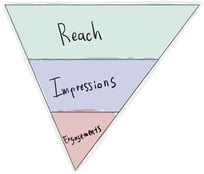When any organization invests a substantial amount of time, money, and resources into an internal communications campaign, they want results.
They want to know which methods are effective, and which are not, before they invest anything else into the campaign. However, success may look different to every company and for every campaign based on the goals that have been set. To create the most effective communications strategy, and to further manage it towards driving positive results, it is essential that the team decides on what the campaign’s purpose is, and how they intend to measure it.
There are a variety of goals that your team can set as the driver for the campaign so you can best measure its effectiveness:
Increase Reach
A company’s “reach” is essentially the number of people who are exposed to the campaign’s initiative. This may be the number of times an employee looks at your internal newsletter, or the number of employees who viewed your training documents. The traffic can be organically generated via passive browsing, or you can direct your employees to your content via notifications and other reminders.
 Different reach goals may call for different strategies. If the goal of your campaign is to increase reach, then it is important that you find ways to measure this to determine whether or not the campaign is successful. One of the more convenient ways to measure reach is with a media monitoring tool. There are a variety of these tools on the market, each designed to meet different needs.
Different reach goals may call for different strategies. If the goal of your campaign is to increase reach, then it is important that you find ways to measure this to determine whether or not the campaign is successful. One of the more convenient ways to measure reach is with a media monitoring tool. There are a variety of these tools on the market, each designed to meet different needs.
Increase Participation
For some, reach is not good enough - they want actual interaction within their communications campaign. This might look a little different for each company. In some cases, the organization might seek more hits on their intranet, and employee advocacy shares of their social media posts.
 In other cases, the campaign may seek interaction directly through surveys and events. If you are seeking to increase participation rather than reach, then your methods of measuring success will look a little different. You would likely be much more interested in tracking conversions. This would show you how many people clicked on your campaign rather than just scrolling over it. You can choose different conversions to track. For example, if your goal is to get people to participate in your company survey, then you can measure how many employees go from your notification to the survey, and even determine how many questions they have answered.
In other cases, the campaign may seek interaction directly through surveys and events. If you are seeking to increase participation rather than reach, then your methods of measuring success will look a little different. You would likely be much more interested in tracking conversions. This would show you how many people clicked on your campaign rather than just scrolling over it. You can choose different conversions to track. For example, if your goal is to get people to participate in your company survey, then you can measure how many employees go from your notification to the survey, and even determine how many questions they have answered.
Reduce Costs
Costs can be reduced in a variety of ways depending on the company. For example, you can send better targeted messages to fewer employees, lowering time spent crafting the message as well as money wasted on uninterested parties. Unlike the other goals, this is the easiest goal to measure from an internal standpoint. It does not typically require the data-tracking software that the other measurements require because more of the data is internal company information. You can simply measure month to month costs. To best correlate this to awareness, compare the decrease in costs to the measurements taken for reach.

No one wants to continue investing in a campaign that does not work. It is important to know adequate ways to measures the effectiveness of your strategy based on the goals you set for the campaign.

